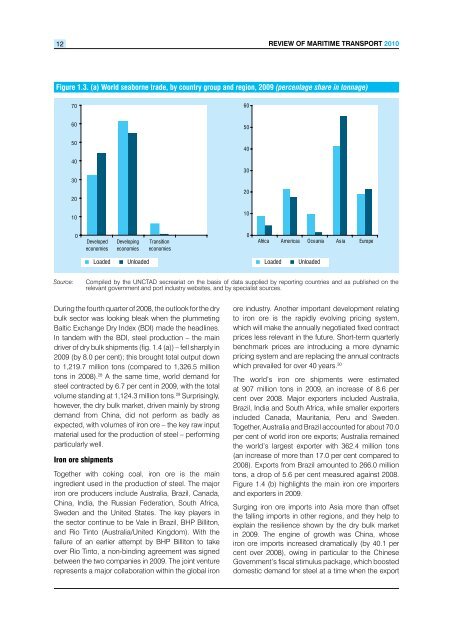Review of Maritime Transport 2010 - Unctad
Review of Maritime Transport 2010 - Unctad
Review of Maritime Transport 2010 - Unctad
Create successful ePaper yourself
Turn your PDF publications into a flip-book with our unique Google optimized e-Paper software.
12<br />
<strong>Review</strong> <strong>of</strong> MaRitiMe tRanspoRt <strong>2010</strong><br />
Figure 1.3. (a) World seaborne trade, by country group and region, 2009 (percentage share in tonnage)<br />
70<br />
60<br />
50<br />
40<br />
30<br />
20<br />
10<br />
0<br />
Developed<br />
economies<br />
Developing<br />
economies<br />
Transition<br />
economies<br />
Loaded Unloaded Loaded Unloaded<br />
Source: Compiled by the UNCTAD secreariat on the basis <strong>of</strong> data supplied by reporting countries and as published on the<br />
relevant government and port industry websites, and by specialist sources.<br />
During the fourth quarter <strong>of</strong> 2008, the outlook for the dry<br />
bulk sector was looking bleak when the plummeting<br />
Baltic Exchange Dry Index (BDI) made the headlines.<br />
In tandem with the BDI, steel production – the main<br />
driver <strong>of</strong> dry bulk shipments (fig. 1.4 (a)) – fell sharply in<br />
2009 (by 8.0 per cent); this brought total output down<br />
to 1,219.7 million tons (compared to 1,326.5 million<br />
tons in 2008). 28 A the same time, world demand for<br />
steel contracted by 6.7 per cent in 2009, with the total<br />
volume standing at 1,124.3 million tons. 29 Surprisingly,<br />
however, the dry bulk market, driven mainly by strong<br />
demand from China, did not perform as badly as<br />
expected, with volumes <strong>of</strong> iron ore – the key raw input<br />
material used for the production <strong>of</strong> steel – performing<br />
particularly well.<br />
iron ore shipments<br />
Together with coking coal, iron ore is the main<br />
ingredient used in the production <strong>of</strong> steel. The major<br />
iron ore producers include Australia, Brazil, Canada,<br />
China, India, the Russian Federation, South Africa,<br />
Sweden and the United States. The key players in<br />
the sector continue to be Vale in Brazil, BHP Billiton,<br />
and Rio Tinto (Australia/United Kingdom). With the<br />
failure <strong>of</strong> an earlier attempt by BHP Billiton to take<br />
over Rio Tinto, a non-binding agreement was signed<br />
between the two companies in 2009. The joint venture<br />
represents a major collaboration within the global iron<br />
60<br />
50<br />
40<br />
30<br />
20<br />
10<br />
0<br />
Africa Americas Oceania Asia Europe<br />
ore industry. Another important development relating<br />
to iron ore is the rapidly evolving pricing system,<br />
which will make the annually negotiated fixed contract<br />
prices less relevant in the future. Short-term quarterly<br />
benchmark prices are introducing a more dynamic<br />
pricing system and are replacing the annual contracts<br />
which prevailed for over 40 years. 30<br />
The world’s iron ore shipments were estimated<br />
at 907 million tons in 2009, an increase <strong>of</strong> 8.6 per<br />
cent over 2008. Major exporters included Australia,<br />
Brazil, India and South Africa, while smaller exporters<br />
included Canada, Mauritania, Peru and Sweden.<br />
Together, Australia and Brazil accounted for about 70.0<br />
per cent <strong>of</strong> world iron ore exports; Australia remained<br />
the world’s largest exporter with 362.4 million tons<br />
(an increase <strong>of</strong> more than 17.0 per cent compared to<br />
2008). Exports from Brazil amounted to 266.0 million<br />
tons, a drop <strong>of</strong> 5.6 per cent measured against 2008.<br />
Figure 1.4 (b) highlights the main iron ore importers<br />
and exporters in 2009.<br />
Surging iron ore imports into Asia more than <strong>of</strong>fset<br />
the falling imports in other regions, and they help to<br />
explain the resilience shown by the dry bulk market<br />
in 2009. The engine <strong>of</strong> growth was China, whose<br />
iron ore imports increased dramatically (by 40.1 per<br />
cent over 2008), owing in particular to the Chinese<br />
Government’s fiscal stimulus package, which boosted<br />
domestic demand for steel at a time when the export

















